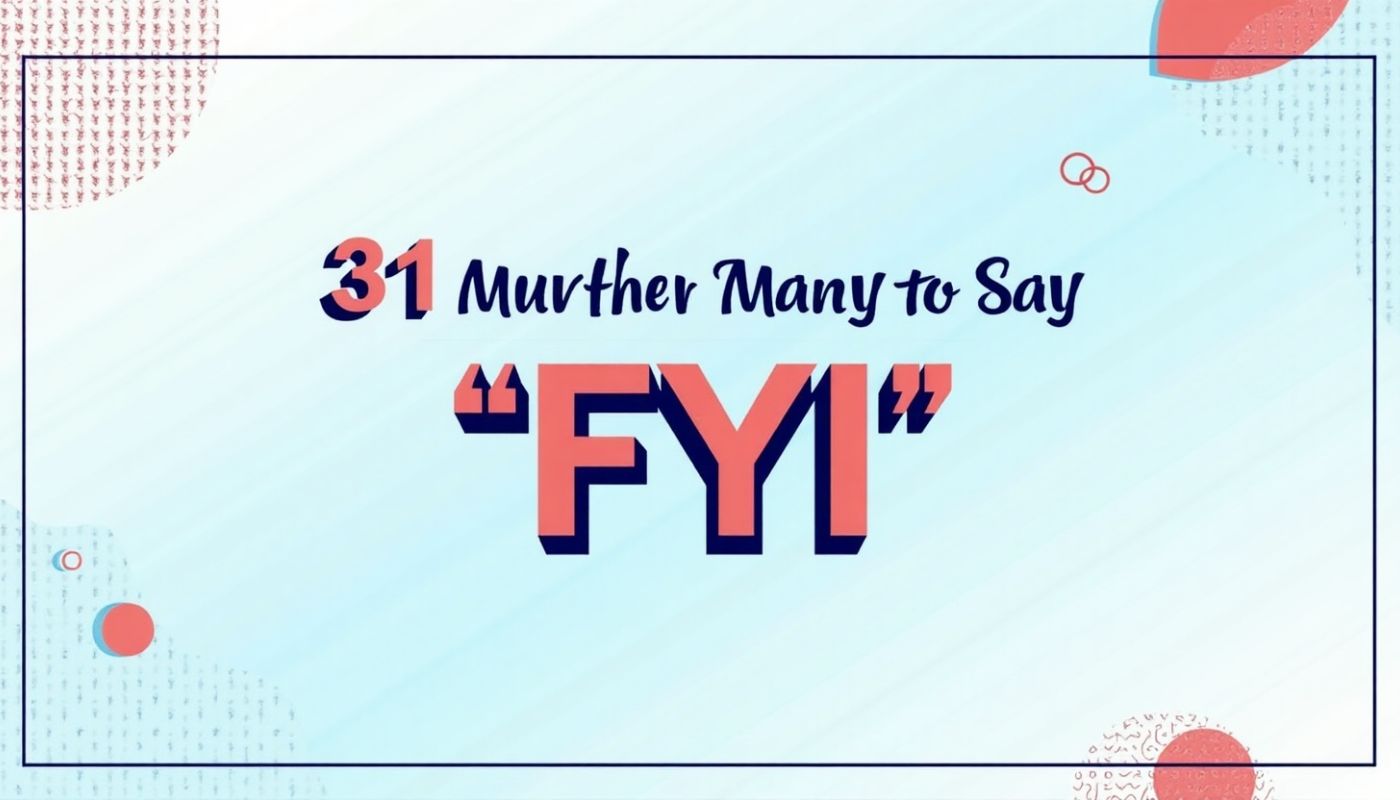In communication, variety is key. Sometimes, overusing the same phrase can make your message feel repetitive, and that’s where alternatives come in! “FYI” is a commonly used phrase, but there are plenty of other ways to convey the same meaning.
Whether you’re sending a professional email, giving a friendly reminder, or just passing on information, these alternatives will help keep your message fresh and engaging.
For Your Information
This is a direct and clear alternative to “FYI.” It’s simple, professional, and appropriate for a wide range of contexts. It communicates the idea of sharing important information without any unnecessary flair.
Example:
- “For your information, the annual report is due by Friday.”
When to Use:
- Best for formal communication or when you need to ensure that the message is clear and professional.
Heads Up
“Heads up” has a more informal tone than “FYI.” It suggests a quick alert and is often used when you want someone to be aware of something upcoming, like a change or important event.
Example:
- “Heads up: The meeting has been pushed to 3 PM.”
When to Use:
- Great for informal conversations, casual emails, or when you want to convey a sense of urgency.
Note
A concise and formal way to share information, “note” works well when you want to draw attention to something important without making it feel too casual or too stiff.
Example:
- “Please note that all files need to be uploaded by end of day.”
When to Use:
- Ideal for professional emails, memos, and formal notices.
Quick Note
“Quick note” softens the tone a bit, indicating that the information being shared doesn’t require much time or attention but still holds value.
Example:
- “Quick note: The client has requested a change to the project timeline.”
When to Use:
- Suitable for short, quick messages in both professional and casual contexts.
Update
“Update” is a great alternative when you want to inform someone about new or recent developments, especially if they may be expecting further communication.
Example:
- “Update: The budget approval has been delayed until next week.”
When to Use:
- Great for providing new information or changes that your audience needs to be aware of.
Informative
This alternative is a bit more formal and implies that the information being shared is both useful and relevant. It’s often used in more structured communications.
Example:
- “This document is informative about the upcoming changes to the software.”
When to Use:
- Ideal for more formal, educational, or informative emails.
FYA (For Your Awareness)
FYA is a shorter, more casual way to say “For Your Awareness.” It’s commonly used in emails or messages where brevity is key.
Example:
- “FYA: The event has been moved to next week.”
When to Use:
- Casual emails, internal team messages, or informal communication.
In the Loop
“In the loop” is a friendly way to indicate that you want someone to stay informed and updated about a specific situation or topic.
Example:
- “I wanted to keep you in the loop about the status of the project.”
When to Use:
- Ideal for collaborative work environments and team-based communication.
Sharing
“Sharing” is a more personal way to convey that you’re passing along something of value. It adds a touch of warmth to the message.
Example:
- “Sharing this report with you for your reference.”
When to Use:
- Suitable for less formal contexts, or when you want to create a sense of community or teamwork.
Update Alert
“Update alert” implies that the information being shared is an important update, similar to “heads up,” but with more emphasis on the urgency or significance.
Example:
- “Update alert: The deadline has been moved to next Thursday.”
When to Use:
- When you need to grab someone’s attention quickly, often in work or business settings.
Insight
“Insight” suggests that you’re providing someone with valuable or useful information that will help them make a more informed decision or gain a deeper understanding of a situation.
Example:
- “Here’s some insight into the current market trends that could affect our sales strategy.”
When to Use:
- Great for professional environments, especially when sharing data, reports, or analysis.
Just a Reminder
“Just a reminder” is a soft, polite way to bring someone’s attention to something they might have forgotten or need to pay attention to.
Example:
- “Just a reminder, the submission deadline is tomorrow.”
When to Use:
- Perfect for friendly emails or text messages where you don’t want to sound too abrupt.
Informing
“Informing” is a straightforward way to let someone know you’re passing along important information. It’s less casual than “sharing” but not as formal as “for your information.”
Example:
- “Informing you that your request has been approved.”
When to Use:
- Suitable for professional, yet not overly formal, situations.
Something to Know
This phrase feels casual and conversational, ideal for a setting where you want to pass along helpful information without making it sound overly formal or rigid.
Example:
- “Something to know: The meeting has been moved to 2 PM.”
When to Use:
- Perfect for informal settings, quick chats, or messages that are meant to feel more personal.
FYI Meaning
“FYI” stands for “For Your Information.” It’s commonly used to share important details or updates with someone, often without the expectation of a response.
Example:
- “FYI, we will be having lunch at 12 PM.”
Context:
- It’s frequently used in emails, texts, or casual conversations when conveying information that’s not urgent.
FYI Meaning in Chat
In casual chats, “FYI” serves as a quick way to share information that might be helpful or interesting to the other person. It’s a great shorthand for informal exchanges.
Example:
- “FYI, I just sent the files over to you.”
Context:
- Often used in messaging apps or text conversations to pass along quick updates.
FYI Example
Here’s an example of how “FYI” can be used in a sentence:
Example:
- “FYI, we’ve moved the team meeting to 3 PM.”
Context:
- It’s commonly used when sharing updates or reminders in a short, direct format.
FYI in a Sentence
A sentence using “FYI” might look like this:
- “FYI, the event is scheduled for next Monday at 10 AM.”
Context:
- Ideal for adding a brief piece of information without requiring further explanation or conversation.
FYI in Email
In an email, “FYI” is typically used to introduce information that the recipient needs to be aware of but doesn’t necessarily require an immediate response.
Example:
- “FYI, the office will be closed for a holiday on Friday.”
Context:
- It’s widely used in both professional and casual emails for providing updates or reminders.
FYI Docs
When sharing documents or files, “FYI” is often used as a heads-up to let the recipient know that the document is for their awareness.
Example:
- “FYI, I’ve attached the revised report for your review.”
Context:
- Commonly used in professional settings when sharing documents or files with colleagues or clients.
Is FYI Rude?
“FYI” is generally not considered rude, but tone can make a difference. If used in an abrupt or overly casual way, it may come across as dismissive. To avoid this, be mindful of the context in which you use it.
Example:
- “FYI, the meeting is at 9 AM” may seem curt, but adding a friendly tone like “Just FYI, the meeting is at 9 AM” makes it sound more polite.
Context:
- Use it respectfully and with consideration for the relationship you have with the recipient.
FYI Meaning from a Girl
The meaning of “FYI” from anyone, including a girl, remains the same: it’s a quick, casual way to share information.
Example:
- “FYI, I’m running a bit late, but I’ll be there in 15 minutes.”
Context:
- Often used in text messages or chats to pass along helpful updates without the need for an immediate response.
FYI Stand For
“FYI” stands for “For Your Information,” a shorthand way to communicate information without requiring immediate feedback.
Example:
- “FYI, the conference has been rescheduled for next month.”
Context:
- Commonly used in both informal and professional settings to relay information quickly.
FYI Meaning in Email
In an email context, “FYI” is often used to introduce an update or piece of information that’s relevant to the recipient but doesn’t necessarily require a response.
Example:
- “FYI, I’ve updated the presentation as per your feedback.”
Context:
- Suitable for professional communication where you’re simply informing someone of a change or update.
FY
“FY” is sometimes used as an abbreviation for “FYI” or “For Your” in more casual settings, especially in informal conversations or text messages.
Example:
- “FY, the deadline has been extended.”
Context:
- More common in text messages or informal online chats.
FYA
“FYA” stands for “For Your Awareness,” which is a shorter version of “For Your Information,” typically used in professional or business environments.
Example:
- “FYA, the meeting has been moved to next week.”
Context:
- Ideal for emails or workplace communication where brevity is appreciated.
Professional Way to Say FYI
A more professional alternative to “FYI” is “For your information.” This phrase maintains clarity and formality, making it suitable for business emails or official memos. It’s straightforward and respectful, making sure that the recipient knows the importance of the information being shared without being overly casual.
Example:
- “For your information, the project deadline has been moved to next Friday.”
When to Use:
- Ideal for formal emails, business communications, or any situation where professionalism is key.
Other Ways to Say FYI
Another effective alternative is simply using “Just to let you know.” This phrase is a little more conversational but still maintains a level of professionalism. It’s a great option for when you want to share information quickly without sounding too stiff or formal.
Example:
- “Just to let you know, the team has completed the initial review of the document.”
When to Use:
- Perfect for work-related emails or informal communication where you want to share updates in a friendly, yet professional, manner.
FYI Synonym
An excellent synonym for FYI is “For your awareness.” It communicates the same idea of keeping someone informed but with a slightly more formal tone. This phrase is great for professional settings where you want to emphasize that the recipient should be aware of something, but it doesn’t require action or a reply.
Example:
- “For your awareness, the training session will be held next Thursday at 10 AM.”
When to Use:
- Use it in formal emails or professional contexts when you’re providing updates or sharing information that requires attention but no immediate response.
How to Say FYI Professionally
A professional alternative to “FYI” would be “Please be advised.” This phrase is a bit more direct and is often used in situations where you want to ensure that the recipient pays attention to the information you’re providing. It’s typically used for important updates or notices.
Example:
- “Please be advised that the office will be closed for the holiday on Friday.”
When to Use:
- Best suited for formal notices or when you need to inform someone about an important change, policy, or procedure.
Another Way to Say FYI
Lastly, “I wanted to inform you” is a great way to share information in a clear, direct, and respectful manner. It’s slightly more personal than “For your information” and feels conversational while still maintaining professionalism.
Example:
- “I wanted to inform you that the marketing campaign will launch next week.”
When to Use:
- Perfect for emails or conversations where you want to share an important update while maintaining a balance between professionalism and a friendly tone.
Conclusion
As you can see, there are plenty of ways to communicate important information without relying on “FYI.”
Whether you’re sending an email, having a chat, or updating a team, varying your language helps you stay engaging and professional.
So, feel free to try out these alternatives and watch how they can enhance your communication!

Mark Tony is a grammar expert with 5 years of experience, specializing in teaching English grammar, enhancing writing, reading, and speaking skills for diverse learners.









